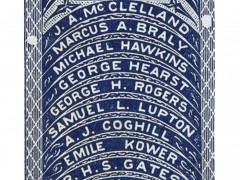On this day: Charles-Nicolas Cochin
Born in Paris, the son of Charles-Nicolas Cochin the Elder (1688–1754), under whom he studied engraving, Charles-Nicolas Cochin was a French engraver, designer, writer, and art critic.
Cochin rose quickly to success and fame. As early as 1737, he was employed by the young King Louis XV to make engravings to commemorate every birth, marriage, and funeral at the king's court, and from 1739 he was formally attached as designer and engraver to the Menus-Plaisirs du Roi, where all such ephemeral occasions were produced.
As well as being an engraver to the court, he was also a designer, a writer on art, and a portrait artist. Cochin saw himself as an educator and was critical of the Rococo style, whose extravagance he publicly criticised in letters in the Mercure de France.
More than fifteen hundred works by Cochin can be identified. They include historical subjects, book illustrations, and portraits in pencil and crayon. The richest collection of his engravings, apparently selected by himself, is in the Royal Library, now part of the Bibliothèque nationale.
In 1912, a typeface named Cochin, in honor of the artist, was designed by Georges Peignot. The style was inspired by Cochin's engravings, however, it is not a direct copy of those presented in the prints.
The serif typeface was originally produced in 1912 by Peignot for the Paris foundry G. Peignot et Fils (future Deberny & Peignot) and was based on the copperplate engravings of 18th century French artist Charles-Nicolas Cochin, from which the typeface also takes its name.
The font has a small x-height with long ascenders. Peignot also created the design 'Nicolas-Cochin' as a looser variation in the same style.
With a very low x-height and delicate design, Cochin is described by Walter Tracy an example of a style of lettering and graphic design popular in the early twentieth century in several countries.
In 1927 Monotype UK produced a typeface Cochin Series 165, Roman and Italic, based on an 1812-face Cochin 18c of the Peignot-foundry.
By 1977 Cochin was adapted and expanded by Matthew Carter for Linotype, and this four-weight version is well-known today as a system font on macOS.
The original and 'Nicolas-Cochin' designs were also digitised by LTC and Linotype, and other versions are available from others including URW++, which adds an additional black weight not available from Linotype.
The typeface is used in the Harry Potter covers produced by Bloomsbury Publishing, in The Spiderwick Chronicles (written by Holly Black and Tony DiTerlizzi) and in many of The Editorial Nascimento of Santiago Chile 6500 publications, which included books by Pablo Neruda and Gabriela Mistral from 1923 onwards.
Cochin was previously a font option in iBooks for the iPad but was replaced in version 1.5 when Athelas, ITC Charter, Iowan Old Style, and Seravek were added. Last but not least, the English alternative rock band Keane used the typeface for their first official logo.
Charles-Nicolas Cochin was born in 22 February 1715 and he passed away on the 29th of April 1790.
Tags/ typeface, monotype, linotype, serif font, engraver, on this day
.jpg)





.jpg)









.jpg)



